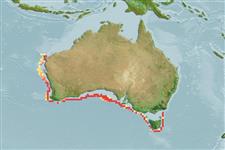Teleostei (teleosts) >
Gadiformes (Cods) >
Macrouridae (Grenadiers or rattails)
Etymology: Nezumia: A Japanese word that means "mouse".
Eponymy: Named after the CSIRO (Australian Commonwealth Scientific and Industrial Research Organisation) fisheries research vessel ‘Soela’, from which some of the holotypes were collected and which has contributed substantially to collections of fishes [...] (Ref. 128868), visit book page.
More on authors: Iwamoto & Williams.
Environment: milieu / climate zone / depth range / distribution range
Ecology
Marine; bathydemersal; depth range 830 - 1500 m (Ref. 35909). Deep-water
Eastern Indian Ocean: Western Australia.
Size / Weight / Age
Maturity: Lm ? range ? - ? cm
Max length : 35.0 cm TL male/unsexed; (Ref. 35909)
Dorsal spines (total): 2; Anal spines: 0. Pelvic fin rays 10-11; first dorsal fin with 10 or 11 segmented rays (rarely 12); underside of snout with broad naked median swath, pores of lateralis system small, inconspicuous; body scales covered with narrow, lanceolate spinules in slightly convergent rows; 7-9.5 scale rows below origin of second dorsal fin, 36-41 lateral line scales over distance equal to predorsal length; trunk lacking prominent broad dark girdle; first dorsal fin all black; anterior dermal window of light organ more or less on transverse line connecting pelvic fin insertions; upper jaws 29-33% of HL; orbit to preopercular distance 33-38% of HL; inner gill rakers on first arch 10-13.
A benthic species found on the continental slope (Ref. 75154).
Life cycle and mating behavior
Maturity | Reproduction | Spawning | Eggs | Fecundity | Larvae
Iwamoto, T. and A. Williams, 1999. Grenadiers (Pisces, Gadiformes) from the continental slope of western and northwestern Australia. Proc. Calif. Acad. Sci. 51(3):105-243. (Ref. 35909)
IUCN Red List Status (Ref. 130435: Version 2024-2)
Human uses
Tools
Special reports
Download XML
Internet sources
Estimates based on models
Preferred temperature (Ref.
123201): 2.1 - 5.5, mean 4.6 °C (based on 50 cells).
Phylogenetic diversity index (Ref.
82804): PD
50 = 0.5000 [Uniqueness, from 0.5 = low to 2.0 = high].
Bayesian length-weight: a=0.00214 (0.00109 - 0.00421), b=3.20 (3.03 - 3.37), in cm total length, based on LWR estimates for this (Sub)family-body shape (Ref.
93245).
Trophic level (Ref.
69278): 3.3 ±0.1 se; based on size and trophs of closest relatives
Resilience (Ref.
120179): Low, minimum population doubling time 4.5 - 14 years (Preliminary K or Fecundity.).
Fishing Vulnerability (Ref.
59153): Low vulnerability (25 of 100).
